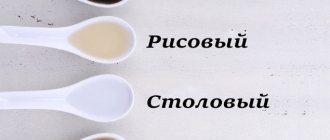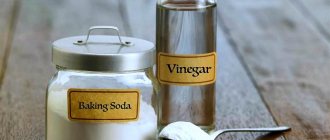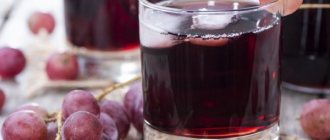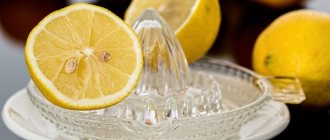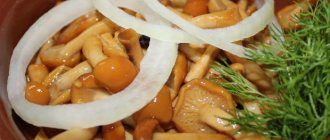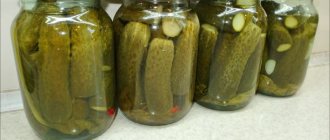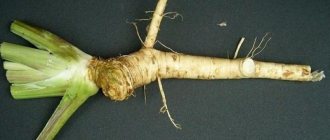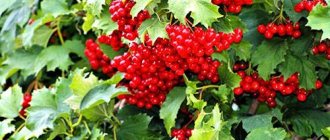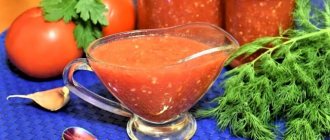Often housewives are faced with the question of how to make 6 percent vinegar from 9 percent vinegar. This is a simple procedure that even a newbie in the kitchen can handle. The main thing is clarity and accuracy of proportions. Learn how to convert one concentration to another.
For dilution, use only glass containers
Scope of application of 9% vinegar
Table 9% solution is a specially developed liquid product characterized by a specific odor and sour taste. First, let's tell you in what area acid is used. A composition with a low percentage is used when preparing dishes, in the fight against pests of garden plants and indoor flowers.
Do not forget that an almost universal remedy is stored in the kitchen cabinet - acetic acid. It disinfects surfaces, helps clean stubborn dirt, and remove sweat stains from clothes.
Vinegar is used in baking, when preserving vegetables for the winter, marinades for meat and fish. Also added to borscht, cabbage soup, and vegetable salads. Different concentrations are used in the following areas:
- A 3% solution is used to wipe off high fever in children;
- added for cosmetic purposes when creating masks, creams as a preservative;
- 5% is used for seasoning manti and dumplings - diluted with water and dipped into the product mixture;
- the mixture is used to season salads of tomatoes, cucumbers, peppers and herbs;
- for making vinaigrette;
- 6% is added to the dough to make pancakes and pies fluffy and tall; the substance also makes baked goods airy;
- for preparing marinade for barbecue, chicken, fish;
- marinate old beef in it to soften it;
- in medicine for applying compresses for pain;
- cucumbers, tomatoes, and mushrooms are preserved for the winter;
- as a food additive E 260 is added to preserves;
- for preparing borscht dressing, pickle;
- quickly removes scale and lime deposits in the kettle;
- to rid the refrigerator of foul odors;
- disinfection of tools, plumbing fixtures;
- a higher concentration can remove rust and break down fat.
The procedure for converting one percentage to another requires accurate measurement of proportions. To properly dilute vinegar from 9 to 6 percent, follow the indicated proportions.
Basic definitions of vinegar
Vinegar is familiar to us with its sour taste and specific pungent odor. The history of its discovery dates back to 5000 BC. For many centuries, in medicine, cooking, and everyday life, only a natural product was used, obtained with the help of acetic acid bacteria from food raw materials: fermented wine, fruit juices, ethyl alcohol.
The main properties, taste and characteristic smell are due to the rich, varied composition:
- Organic acids (mainly acetic acid, but also malic, citric, tartaric, etc.);
- Aldehydes;
- Esters and alcohols;
- Amino acids, macro- and microelements.
With the development of industry at the end of the 19th century, the production of synthetic acetic acid began, mainly from wood. Later they began to synthesize it from food raw materials.
Absolute acetic acid, the concentration of which is close to 100%, is called glacial. This very caustic substance requires careful handling and is not used in everyday life. But its concentrated 30% - 80% aqueous solutions can be found on store shelves. The most popular vinegar essence is 70% strength.
Important! Under no circumstances should vinegar essences be used without dilution with water. Concentrated acetic acid causes severe burns to the mucous surfaces of internal organs. Read the label carefully!
In cooking, table vinegar of 3, 6 or 9% strength is mainly used.
Delicious recipe! Used to prepare Pozharsky cutlets
It is preferable to use a natural product (this is necessarily indicated in the name on the label), which has additional nutritional value, distinctive taste and aroma.
A synthetic analogue - an aqueous solution of concentrated acetic acid - has the taste and smell only of this organic substance.
Calculation formulas
In old recipes, it was six percent vinegar that was indicated. At that time, manufacturers focused specifically on this composition. Table vinegar 9% appeared in stores only in the 21st century.
If the initial quantity is known
To properly dilute 9 percent vinegar to 6%, you need to understand how much you will need for cooking. Then convert to grams, the indicator will be the final value. Multiply the required amount of solution by the available percentage of vinegar and divide by the percentage of the desired consistency. The result is a universal formula that is accurate.
Do you dilute vinegar at home?
Not really
For example, you close cucumbers and peppers for the winter. The recipe specifies 100 g of a 6% solution, but you only have 9% vinegar in your cupboard. Calculate like this:
(100g x 9%)/ 6=150g.
That is, from 100 g of acid you will get 150 g of a 6% solution. To do this, 100 g of 9% is combined with 50 g of water. The proportion in the example is 1:1.5.
If the required amount is known 6%
There is a second option that allows you to transfer vinegar. The amount of initial solution is equal to the desired percentage, multiplied by the final volume and divided by the initial percentage of vinegar.
Let's look at an example with the following notation:
X – 9% solution
A – volume of vinegar 6%
C is the strength of the solution, in this case it is 9
B – percentage to be calculated – 6%.
X = (A x B)/C
If you have 9% acid in the amount of 200 g in your kitchen, then add to the formula:
200x6/9 = 133.3 ml.
To obtain 200 g of a 6% solution, you need to take 133.3 ml of 9% acid and add 66.7 ml of water to it.
You can dilute 9 percent vinegar to 6% using 30% water. If you have 1 liter of 9% vinegar, then you need to pour 300 g of cold boiled water into it.
Concentration conversion using a spoon
If you need a small amount of vinegar, you can use a regular spoon. To better navigate, find out how many ml are in a tablespoon of vinegar. Its size - dessert, table or tea - depends on the final volume.
Author's note
Agapov Vladislav
To transfer vinegar, take 2 spoons of 9% and 1 spoon of water. The ratio here is 2:1.
How to transfer a 6% solution using a glass
To convert 9% acid to 6%, it is better to use a glass rather than a spoon. First boil the water and cool it. Then pour the 9% solution into the container, filling up to 2/3. All you have to do is add water until the glass is full.
To obtain a 6% solution from 9%, pour 1/3 of water into 2/3 of it. If you need to get a six percent composition, you can use a medical glass instead of a simple glass.
Also see how to dilute vinegar 70 to 9 in the table in spoons.
Translation using a glass
If you plan to prepare a large amount of preserves for the winter and you need a lot of vinegar, use a 250 ml glass, this is a faceted vessel filled to the brim.
You need to get 375 g of a 6% solution. To do this, add 250 g of 9% acid with water.
Interesting video:
We measure out the required amount
The recipe includes such measurement methods as a tablespoon, dessert or teaspoon, or glass. Other recipes indicate the weight or volume of the solution - milliliters and grams. How to determine how much a dessert spoon weighs? The table below will help you understand the weight.
| Name of container | Weight in g | Volume in ml |
| 1 tsp. | 5 | 5 |
| 1. d.l. | 10 | 10 |
| 1 tbsp. l. | 15 | 15 |
| Cup | 250 | 250 |
Minor measurement errors remain. It is believed that the weight in grams is greater than the volume. But pinpoint precision is required only in pharmaceutical recipes. For cooking, it is enough to know that the weight of vinegar, like water, is comparable to its volume.
Knowing the volume of the product in ml, you can calculate the number of spoons. So, 25 ml of otsta is 1 tablespoon and 1 dessert spoon each. 3 tablespoons and 1 teaspoon can replace 50 ml of product. 5 tablespoons converted to milliliters - 75 ml. 100 ml of product is equal to 6 tablespoons and 1 dessert spoon.
Measurement can be done in another way. It is relevant when preparing marinades where high acidity is required. Half a glass - 125 g, a quarter - 62.5 g. Since acetic acid liquid is practically not used in its pure form, it is not so much the weight of the product that is important, but its relationship with the recipe ingredients.
Dilution table
A table for diluting types of vinegar and water is presented for visual use by housewives. It is designed not just for informational purposes. If you prepare a brine with undiluted essence, the vegetables may turn into a mush that is unsuitable for consumption. Find out if you can use balsamic vinegar.
| Conversion table for acetic acid concentrations per 1 liter of solution | ||||||||
| Concentration of the resulting solution | Initial concentration of acetic acid | |||||||
| 60% | 70% | 80% | 90% | |||||
| Acid, ml | Water, ml | Acid, ml | Water, ml | Acid, ml | Water, ml | Acid, ml | Water, ml | |
| 2% | 33 | 967 | 29 | 971 | 25 | 975 | 22 | 978 |
| 2,5% | 42 | 958 | 36 | 964 | 31 | 969 | 28 | 972 |
| 3% | 50 | 950 | 43 | 957 | 38 | 963 | 33 | 967 |
| 3,5% | 58 | 942 | 50 | 950 | 44 | 956 | 39 | 961 |
| 4% | 67 | 933 | 57 | 943 | 50 | 950 | 44 | 956 |
| 4,5% | 75 | 925 | 64 | 936 | 56 | 944 | 50 | 950 |
| 5% | 83 | 917 | 71 | 929 | 63 | 938 | 56 | 944 |
| 5,5% | 92 | 908 | 79 | 921 | 69 | 931 | 61 | 939 |
| 6% | 100 | 900 | 86 | 914 | 75 | 925 | 67 | 933 |
| 6,5% | 108 | 892 | 93 | 907 | 81 | 919 | 72 | 928 |
| 7% | 117 | 883 | 100 | 900 | 88 | 913 | 78 | 922 |
| 7,5% | 125 | 875 | 107 | 893 | 94 | 906 | 83 | 917 |
| 8% | 133 | 867 | 114 | 886 | 100 | 900 | 89 | 911 |
| 8,5% | 142 | 858 | 121 | 879 | 106 | 894 | 94 | 906 |
| 9% | 150 | 850 | 129 | 871 | 113 | 888 | 100 | 900 |
| 9,5% | 158 | 842 | 136 | 864 | 119 | 881 | 106 | 894 |
| 10% | 167 | 833 | 143 | 857 | 125 | 875 | 111 | 889 |
How to use the vinegar concentration calculator
Many housewives are faced with a situation where the recipe for a dish calls for 5% vinegar, but only 70% essence is on hand. In order to dilute the acid to the required value, you can use the online vinegar concentration calculator - it’s very simple, quick and easy.
All you need to do is enter information in special lines about what concentration of vinegar you need to get, what volume of preservative is required, and the concentration of acid that will be used as a base. It is also necessary to introduce a measure for measuring the vinegar product - milliliters, grams, teaspoons, dessert or tablespoons, or faceted glasses.
After entering the data online, the calculator will instantly calculate the required amount of vinegar base and water for dilution.
How to get 6% acid from essence
The question often arises of how to dilute 6% vinegar from 70% essence. Since concentrated acid is very economical, housewives use it quite often. To make 6% vinegar, you will need clean, boiled water, a steel tablespoon, and glassware. Sequencing:
- Scoop the essence into a spoon and pour into a bowl.
- Fill a glass with water and place 11 tablespoons of water in a bowl.
- All that remains is to mix the solution thoroughly.
When 6% vinegar is ready, use as directed. One bottle of essence will last for many months.
Proportions are calculated using a measuring cup
From vinegar essence 70% you will get not only a low concentrated solution of 6%, but also other compositions. In the example, 1 tablespoon is taken:
- from essence and 1.5 tbsp. l. boiled water will make a 30% solution;
- 6 tbsp. l. water – 10%;
- 7 tbsp. l. – 9% mixture;
- 8 tbsp. l. liquids – 8%;
- 9 tbsp. l. – 7%;
- 13th century l. - 5%;
- 17th century l. - 4%;
- 22.5 tbsp. l. – 3%.
Store bottles often indicate how much essence is taken for dilution. Usually they print 1:20, but this is not correct information. Sometimes manufacturers do not indicate proportions at all. Prepare the preservative at home, see the recipe on how to make vinegar matka at home.
Measuring table of vinegar in grams and milliliters “How much vinegar in a tablespoon and a teaspoon”
| How many tablespoons is this? | tablespoons | dessert spoons | teaspoons |
| 200 grams (ml.) vinegar | 13 | 1 | |
| 200 grams (ml.) vinegar | 20 | ||
| 150 grams (ml.) vinegar | 10 | ||
| 150 grams (ml.) vinegar | 15 | ||
| 100 grams (ml.) vinegar | 6 | 1 | |
| 100 grams (ml.) vinegar | 6 | 2 | |
| 100 grams (ml.) vinegar | 10 | ||
| 100 grams (ml.) vinegar | 20 | ||
| 90 grams (ml.) vinegar | 6 | ||
| 80 grams (ml.) vinegar | 5 | 1 | |
| 75 grams (ml.) vinegar | 5 | ||
| 70 grams (ml.) vinegar | 4 | 2 | |
| 70 grams (ml.) vinegar | 4 | 1 | |
| 65 grams (ml.) vinegar | 4 | 1 | |
| 60 grams (ml.) vinegar | 4 | ||
| 50 grams (ml.) vinegar | 3 | 1 | |
| 45 grams (ml.) vinegar | 3 | ||
| 40 grams (ml.) vinegar | 2 | 2 | |
| 40 grams (ml.) vinegar | 4 | ||
| 40 grams (ml.) vinegar | 8 | ||
| 35 grams (ml.) vinegar | 2 | 1 | |
| 30 grams (ml.) vinegar | 2 | ||
| 30 grams (ml.) vinegar | 3 | ||
| 30 grams (ml.) vinegar | 6 | ||
| 25 grams (ml.) vinegar | 5 | ||
| 20 grams (ml.) vinegar | 1 | 1 | |
| 20 grams (ml.) vinegar | 2 | ||
| 20 grams (ml.) vinegar | 4 | ||
| 15 grams (ml.) vinegar | 1 | ||
| 10 grams (ml.) vinegar | 1 | ||
| 5 grams (ml.) vinegar | 1 |
Most often you can find table vinegar or just vinegar in stores. The most popular of them are 3% , 6% and 9% . Three and six percent vinegar is most often used for salads. Nine percent ( 9% ) vinegar is usually used for marinades.
If you liked our vinegar measurement chart, please check out our most comprehensive food measurement chart.
Some rules
To obtain 6% of the composition, use cold purified or boiled water. There is a lot of information on the forums suggesting using an online calculator. He will quickly calculate the volume.
Do you use an online calculator for diluting vinegar?
Not really
If you find that the manufacturer states 1 part vinegar, they mean a tablespoon. To obtain 3% vinegar, take 70% essence and dilute it in 22 or 22.5 parts of liquid. To prepare a 4% solution, take 1 part 70% and add 17 parts water.
Author's note
Agapov Vladislav
To dilute the essence to a 5% solution, use a ratio of 1:13. For 1 tablespoon of acid, take 13 tablespoons of liquid. To prepare a 6% mixture, dilute with water in a ratio of 1:11.
Terms of use:
How many grams (ml.) of vinegar in a spoon
| Types of spoons | Amount of vinegar (table vinegar, vinegar essence, acetic acid) |
| In a tablespoon | 15 grams (ml.) |
| In a teaspoon | 5 grams (ml.) |
| In a dessert spoon | 10 grams (ml.) |
A tablespoon contains vinegar
One tablespoon holds 15 ml or 15 grams of vinegar
Dessert spoon contains vinegar
One dessert spoon holds 10 ml or 10 grams of vinegar
A teaspoon contains vinegar
A teaspoon holds 5 ml or 5 grams of vinegar
Precautionary measures
Use preservative only with gloves
Hide the solution of any concentration away from children and animals. Keep in a place protected from light. Vinegar is dangerous and can easily cause poisoning. Acid can lead to disruption of the functioning of the gastrointestinal tract, disability and even death.
If the slightest sign of poisoning occurs, you need to call an ambulance, and offer the victim to drink olive oil to slow down the absorption of toxic substances. Then lay the person on his side. This will prevent him from choking on vomit. You cannot induce vomiting yourself; the esophagus can get burned and damaged.
Rules for storing acetic acid
When choosing acetic acid in stores, you should give preference to glass bottles, since plastic containers can release chemical impurities into the liquid when reacting with the acid.
The vinegar solution is a clear liquid that should not contain any flakes, foam, bubbles or other particles. The only exception is fruit vinegar, in which a small sediment is allowed.
You should pay attention to the label, which indicates the name of the manufacturer, address and date of packaging. It should be noted that a synthetic product most often has an unlimited shelf life, unlike its natural counterpart. Fruit essences must be used within six months maximum, otherwise they will expire.
Particular attention should be paid to storing acetic acid. Vinegar is not recommended to be frozen or stored in the refrigerator, or placed near a heat source. A dark kitchen cabinet is ideal. A glass container with a tight-fitting lid is ideal. The storage location must be out of reach of children.
